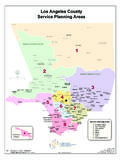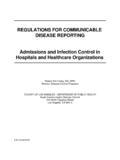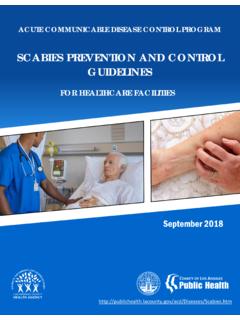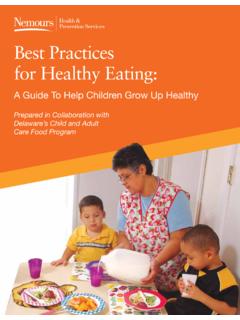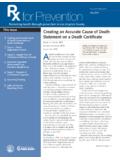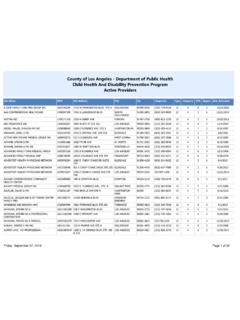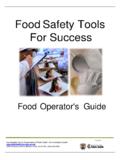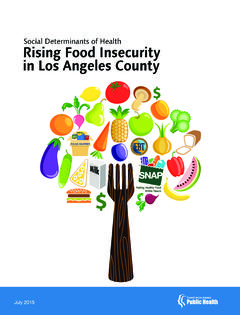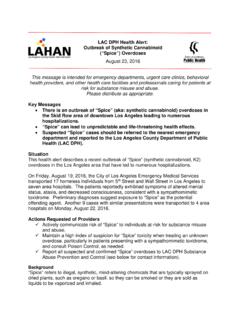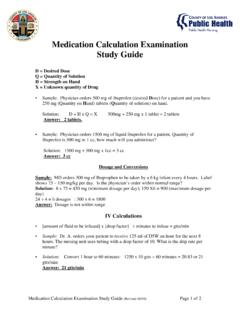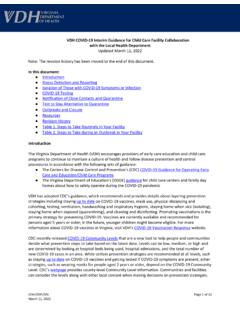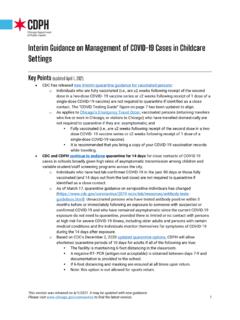Transcription of Guidance for Early Childhood Education Providers ...
1 Guidance for Early Childhood Education Providers Requirements and Best Practices Los Angeles County Department of Public Health 1/11/22 Guidance Early care and Education (English) - 1 - Welcome Given the ongoing community transmission of COVID-19 and the predominant presence of the Delta variant and the Omicron variant, masking indoors and outdoors where distancing is not possible, regardless of vaccination status, is essential to slowing the spread of COVID-19 at events, within businesses, and in the community. The Omicron variant of the virus spreads much more easily than other strains of the virus. To prevent a surge in COVID-19 cases, it is important to diligently follow the requirements and best practices described in this Guidance . Per published reports, factors that increase the risk of infection, including transmission to people more than 6 feet away, include: Enclosed spaces with inadequate ventilation or air handling that allow for build-up of exhaled respiratory fluids, especially very fine droplets, and aerosol particles, in the air space.
2 Increased exhalation of respiratory fluids that can occur when an infectious person is engaged in physical exertion or raises their voice ( , exercising, shouting, singing). Prolonged exposure to these conditions. Below is a summary of requirements and best practices for Early care and Education (ECE) Providers to enhance safety and lower the risk of COVID-19 transmission within their ECE settings as they transition to full operations. In addition to this information, please remember: ECE Providers must comply with applicable Cal/OSHA COVID-19 Prevention Emergency Temporary Standards (ETS) and the LA County Health Officer Order. Please note that the directives in the LA County Health Officer Order must be followed when they are stricter than the Cal/OSHA ETS. ECE Providers should review and follow the general Guidance for businesses. The best practices for ECE described here are intended to supplement the general Guidance .
3 ECE Providers should review the Exposure Management Plan Guidance for Early care and Education Sites, described in more detail below. Follow mask rules for employees, children, and visitors The current Los Angeles County Health Officer Order, requires all individuals, regardless of vaccination status, to wear a mask in all indoor public settings and businesses. This order, and the state s requirement for masking Updates: 01/11/2022: Strong recommendation for all eligible staff to receive a booster dose of a COVID-19 vaccine in addition to their primary vaccine series. Masking now required for all outdoor activities where physical distancing is not feasible, except while eating or drinking. Staff are required to wear upgraded masks (surgical mask or higher-level PPE). Students are strongly recommended to wear masks that are well-fitting, non-cloth masks of multiple layers of non-woven material with a nose wire.
4 Los Angeles County Department of Public Health 01/11/22 Guidance Early care and Education (English) - 2 - Guidance for ECE Providers at child -serving sites, applies to children 2 years (24 months) and older, employees, staff, volunteers, parents, and all visitors. Some exceptions to the masking requirement still apply as noted below. Based on these rules, ECE Providers and sites must: Visitors: Require all visitors, including parents and caregivers, regardless of vaccination status, to bring and wear masks when they are indoors and outdoors where distancing is not possible at their facility. Make masks available to those who arrive without them. Children: Require all children ages 24 months and older to wear a face mask in both indoor and crowded outdoor ECE settings. It is strongly recommended but not required that students wear upgraded masks which at a minimum are well-fitting, non-cloth mask of multiple layers of non-woven material with a nose wire.
5 Nothing in this protocol requires that the ECE site provide upgraded masks to its general student population and parental preference should be respected as to the level of PPE the student wears. However, universal masking with some appropriate type of face covering is required for both indoor and crowded outdoor settings in a ECE program. Masks may be removed during nap time or when children are eating and drinking. Employees: Requirement to provide upgraded masks to all ECE employees: At this time, all ECE employees must be provided with and wear surgical-grade masks (also referred to as medical procedure masks) or higher-level PPE ( , KN95 or N95 respirator masks) when indoors. For those wearing surgical masks, double masking, with a cloth face covering worn over the surgical mask, is recommended for enhanced protection. Cloth face coverings alone are no longer acceptable, as they do not provide the same level of source control or personal protection as a proper surgical mask or higher-level PPE.
6 Full compliance with this directive is expected to occur no later than January 17, 2022. o Consider also offering gloves for tasks such as serving food, diapering, handling trash, or using cleaning and disinfectant products. *Some independent contractors are considered as employees under the State Labor Code. For more details, check the California Department of Industrial Relations Independent contractor versus employee webpage. Screen and respond to cases Entry screenings are strongly recommended to be conducted before employees enter the ECE site. o Entry screening should include a check-in concerning cough, shortness of breath, difficulty breathing and fever or chills and if the employee is currently under isolation or quarantine orders. Temperature checks are recommended if feasible. o These screenings can be done in-person upon arrival at the site or remotely before arrival using a digital app or other verifiable approach.
7 Post signage to remind everyone who enters your establishment that they should NOT enter if they have symptoms of COVID-19 or if they are under isolation or quarantine orders. Exclude any person or isolate any child or staff showing symptoms of a contagious disease or illness until they can be transported home, as required by CDSS Community care Licensing Division (CCLD) and pursuant to Title 22 in CCR sections 101216(h), (a)(1) and 102417(e). o Isolate children who begin to have COVID-19 symptoms while in care , from other children and staff. o Ensure that isolated children continue to receive adequate supervision and that the health of the child is continually observed throughout the day according to licensing requirements. Los Angeles County Department of Public Health 01/11/22 Guidance Early care and Education (English) - 3 - Guidance for ECE Providers Follow public health guidelines for quarantine or isolation if an individual who resides in a family childcare home is exhibiting symptoms of COVID-19.
8 ECE Providers must notify LA County DPH officials, CCLD staff, and families of any confirmed case of COVID-19. Follow the COVID-19 Exposure Management Plan Guidance in Early care and Education Sites for reporting COVID-19 cases to DPH. o Individual cases (1 case) should be reported within 1 business day. o Clusters of 3 or more cases occurring within 14 days should be reported immediately to DPH. Report outbreaks to the CDSS Community care Licensing Division (CCLD) through their local Regional Office as required pursuant to Title 22, CCR section 101212(d). o Family childcare homes must report a communicable disease outbreak, when determined by the local health authority, to CCLD through their local Regional Office pursuant to Title 22, CCR section (c)(3). Refer to the ECE COVID-19 Toolkit for additional information on reporting and managing infections and exposures in the workplace.
9 Consider maintaining physical distancing and stable groups Although physical distancing is no longer required at ECE sites, it is an additional tool for infection control that can be used at ECE sites to reduce the spread of COVID-19. If possible, consider implementing the following measures: Maintain well defined cohorts. Early care and Education settings typically have a stable group model with the same groups of staff and children together each day. ECE Providers should consider steps to maintain a clear separation between groups throughout the day. If feasible, this can help reduce the risk of COVID-19 spread if a child or staff person comes to the site infected. Stagger drop-off and pick-up times to reduce crowding. Consider making it easier for parents and guardians to drop children off at the beginning and end of day to stagger how many children arrive and leave at the same time and prevent crowding at the entryway.
10 Use visual aids to remind children to maintain distance from others. Help children practice physical distancing throughout the day by using visual aids, like tape on the floor or pictures to remind them to maintain their distance from other children and staff. Take steps to make meals safer: o For employees, staff, and volunteers, maintain an outdoor break area where employees can take their breaks. Employees should eat outdoors or alone in a closed office. If employees must eat indoors, they should be distanced by at least 6 feet (about 2 arm lengths) from others if in a shared indoor eating area. o For children, consider having meals outdoors if space and weather permit. When eating indoors, consider moving tables to spread children out or use tape and pictures to indicate where children can sit and help to provide adequate spacing between children. Consider use of barriers and partitions between cubicles to protect staff who are not fully vaccinated and have frequent close contact with other employees or visitors.
